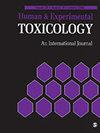Antagonism of G protein-coupled receptor 55 prevents lipopolysaccharide-induced damages in human dental pulp cells
IF 2.7
4区 医学
Q3 TOXICOLOGY
引用次数: 1
Abstract
Pulpitis is a common oral inflammatory disease in dental pulp commonly associated with bacterial infection. G protein-coupled receptor 55 (GPR55) is a member of the G protein‐coupled receptors family that has been found to regulate inflammatory response. However, its roles in dental pulp inflammation have not been investigated. In this study, we used lipopolysaccharide (LPS) to induce inflammation in human dental pulp cells (hDPCs) to simulate an in vitro model of pulpitis. We found that LPS markedly induced the GPR55 expression in hDPCs. Treatment with the GPR55 antagonist ML-193 ameliorated the LPS-caused decrease in cell viability and increase in lactate dehydrogenase release. The upregulated inflammatory cytokines, interleukin-6 (IL-6) and tumour necrosis factor α, in LPS-challenged hDPCs were also attenuated by ML-193. Treatment with ML-193 ameliorated LPS-induced production of the inflammatory mediators cyclooxygenase-2/prostaglandin E2 (COX-2/PGE2), and inducible nitric oxide synthase/nitric oxide (iNOS/NO) in hDPCs. ML-193 also inhibited the activation of Toll-like receptor 4-myeloid differentiation primary response 88-nuclear factor-κB (TLR4-Myd88-NF-κB) signaling in LPS-induced hDPCs via decreased expressions of TLR4, Myd88, and p-NF-κB 65. Our study provides evidence that the GPR55 antagonist ML-193 exhibited anti-inflammatory activity in LPS-stimulated hDPCs through inhibiting TLR4-Myd88-NF-κB signaling. The results imply that ML-193 might be a novel agent for pulpitis.G蛋白偶联受体55的拮抗作用可预防脂多糖诱导的人牙髓细胞损伤
牙髓炎是一种常见于牙髓的口腔炎症性疾病,多与细菌感染有关。G蛋白偶联受体55 (GPR55)是G蛋白偶联受体家族的一员,已发现可调节炎症反应。然而,其在牙髓炎症中的作用尚未被研究。在本研究中,我们使用脂多糖(LPS)诱导人牙髓细胞(hDPCs)炎症,模拟体外牙髓炎模型。我们发现LPS显著诱导了hDPCs中GPR55的表达。用GPR55拮抗剂ML-193治疗可改善lps引起的细胞活力下降和乳酸脱氢酶释放增加。在lps激发的hDPCs中,上调的炎症细胞因子,白细胞介素-6 (IL-6)和肿瘤坏死因子α也被ML-193减弱。ML-193可以改善lps诱导的炎症介质环氧化酶-2/前列腺素E2 (COX-2/PGE2)和诱导型一氧化氮合酶/一氧化氮(iNOS/NO)的产生。ML-193还通过降低TLR4、Myd88和p-NF-κ b65的表达,抑制lps诱导的hDPCs中toll样受体4-髓样分化初级反应88-核因子-κB (TLR4-Myd88- nf -κB)信号通路的激活。我们的研究证明GPR55拮抗剂ML-193通过抑制TLR4-Myd88-NF-κB信号通路对lps刺激的hDPCs具有抗炎活性。结果提示ML-193可能是一种治疗牙髓炎的新型药物。
本文章由计算机程序翻译,如有差异,请以英文原文为准。
求助全文
约1分钟内获得全文
求助全文
来源期刊
CiteScore
5.70
自引率
3.60%
发文量
128
审稿时长
2.3 months
期刊介绍:
Human and Experimental Toxicology (HET), an international peer reviewed journal, is dedicated to publishing preclinical and clinical original research papers and in-depth reviews that comprehensively cover studies of functional, biochemical and structural disorders in toxicology. The principal aim of the HET is to publish timely high impact hypothesis driven scholarly work with an international scope. The journal publishes on: Structural, functional, biochemical, and molecular effects of toxic agents; Studies that address mechanisms/modes of toxicity; Safety evaluation of novel chemical, biotechnologically-derived products, and nanomaterials for human health assessment including statistical and mechanism-based approaches; Novel methods or approaches to research on animal and human tissues (medical and veterinary patients) investigating functional, biochemical and structural disorder; in vitro techniques, particularly those supporting alternative methods

 求助内容:
求助内容: 应助结果提醒方式:
应助结果提醒方式:


